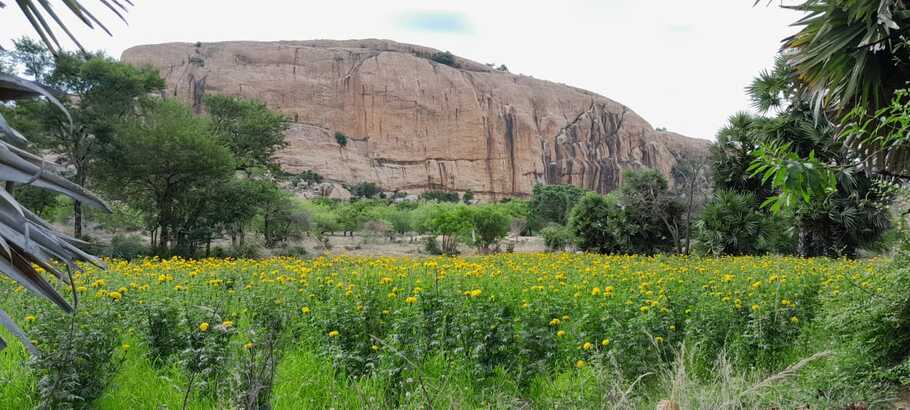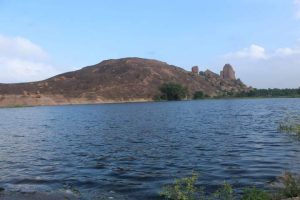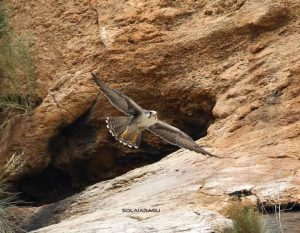
How the laggar falcon helped TN's Arittapatti get Biodiversity Heritage Site status
It was just in 2014 that birders identified the laggar falcon; since then there has been a concerted effort to save the species

Arittapatti’s wildlife story is a rather poignant one. The Tamil Nadu village has been declared a Biodiversity Heritage Site (BHS) because it has lush hillocks that — despite battling the granite mafia — host a wide variety of animals and birds. However, one of its rarest species, the laggar falcon, may not be around long enough to enjoy the special status of the habitat.
More than 450 km from Chennai lies Madurai, the cultural capital of Tamil Nadu. To reach Arittapatti, a village with seven hillocks, one needs to travel another 25 km from Madurai. The hillocks have more than 2,000-year-old Jain beds, sculptures of Jain monks, Tamil Brahmi and Vattezhuthu (a variant of ancient Tamil script) inscriptions, several megalithic structures, and numerous rock-cut cave temples.
Also read: A stranded lone vulture, and its relocation from TN to Rajasthan
Amid these hillocks is Dharmakulam, a pond surrounded by trees. The pond, dotted with lotus flowers, is a perennial drinking water source for the villagers of Arittapatti. It is said that during the Tamil months of Chithirai (mid-April to mid-May) and Vaikasi (mid-May to mid-June), when the mercury soars, there would be drought-like situations in the district, except in this part.
Life-giving water
“One of the reasons is that the hillock region functions as a watershed and supports 72 waterbodies, 200 natural spring pools, and three check dams. Hence, the region has lush vegetation and thriving biodiversity,” A Ravichandran, a resident of the village and an avid birdwatcher, told The Federal.
Also read: How Nilgiris’ tea, exotic plantations are warding off its endemic Shola birds
A local practice passed on down the generations hails the auspiciousness of the pond. A bride who gets married to a groom from this village must fetch water from this pond to cook on the first day of their marriage. It is believed that by doing so, they will be blessed with a child soon.

There were historical, archaeological, and cultural reasons, too, for this village to be declared a BHS. According to the National Biodiversity Authority, BHSs are “well defined areas that are unique, ecologically fragile ecosystems — terrestrial, coastal and inland waters and, marine having rich biodiversity comprising of any one or more of the following components: richness of wild as well as domesticated species or intra-specific categories, high endemism, presence of rare and threatened species, keystone species, species of evolutionary significance, wild ancestors of domestic/cultivated species or their varieties, past pre-eminence of biological components represented by fossil beds and having significant cultural, ethical or aesthetic values and are important for the maintenance of cultural diversity, with or without a long history of human association with them (sic).”
A decade-long fight
On November 22, the Tamil Nadu government declared Arittapatti as its first BHS. These sites are notified under Section 37 of the Biological Diversity Act, 2002. The first such site was declared in Bengaluru in 2007. While Arittapatti residents are happy with the recognition, there is some displeasure over the delay. They feel if it had been done earlier, the precious greenery may have been more effectively preserved from the granite mafia.
“Though Arittapatti is the first BHS in Tamil Nadu, it is not the first one in the country. It is a delayed recognition. Before us, other southern states such as Kerala and Karnataka have got this recognition. We have been fighting for this recognition since 2011, when the granite mafia started to show their ugly face,” said Ravichandran, who spearheaded the Ezhu Malai Pathukappu Sangam (Save Seven Hills Movement) to protect these hillocks from rock sharks.
Also read: How encroachment of water bodies is endangering aquatic birds, avian guests
According to a state government notification, Arittapatti, spread across 139 hectares, is a habitat for around 250 bird species and wildlife such as Indian pangolin, python, and slender loris.
It was to save these hillocks from the granite mafia that birdwatchers like Ravichandran started documenting the local bird species and brought a field guide of birds to explore, in 2014. That was the first time the birders identified the laggar falcon — earlier, it was mistaken for the more common falcon species. From then on, Ravichandran has been organising green and heritage walks to create awareness.
On the verge of extinction
Ravichandran said around 20 kinds of raptors (birds of prey) are found in these hillocks, including three flagship species — laggar falcon, shaheen falcon, and bonelli’s eagle.

It was the laggar falcon — or its rarity — that made the case stronger for the site to get BHS status. Its spotting gave purpose to birdwatchers such as Ravichandran to push for BHS recognition. Once declared a BHS, the hillocks are out of reach of granite quarries, and the natural resources can continue to host various animals and birds.
“In Tamil, the laggar falcon is known as lakudu vallooru. Though its habitat is distributed across the country, it is currently sighted only in Tamil Nadu and Rajasthan. It is disheartening to know that in both these places, only two pairs each exist,” he added. “It is not a migrant species but a resident. So, it can be sighted throughout the year.”
These birds mainly feed on small birds, such as pigeons and chickens, and small mammals and reptiles. Their breeding season is between January and May. A bird lays three to five eggs. However, the species is still not increasing in numbers.
In a paper published in the journal Flamingo Gujarat in 2018, authors Nirav Bhatt and others wrote: “It is very interesting that only three breeding pairs have been recorded in the last 14 years, which is an alarming observation for this species in Gujarat.”
Also read: Paradise reclaimed: How ordinary citizens are helping conserve birds
They also suggested that a detailed study of the breeding of the laggar falcon must be carried out to further monitor the actual population trend and other factors affecting breeding success and/or failures.
Laggar falcons are one of the understudied raptors and, hence, there is no concrete data about their individual population. However, ornithologists estimate that there could be between 13,000 and 15,000 individual birds across the globe. It is generally perceived that these birds face threats such as climate change and pesticide use. The International Union for Conservation of Nature has categorised this species in its Red List as “Near Threatened,” meaning that its population is decreasing rapidly.
Also read: Pallikaranai marshlands in Chennai, now a Ramsar site, is unique
“In the old days, people used to rear chickens and hens in open surroundings. The falcons used to prey on them. But now, due to the developments in the poultry sector, chickens are reared in a closed environment. That affects the falcon’s food chain. Also, it is used to drinking a lot of water. Now, in many places, the water sources are shrinking, which could be a reason why their numbers are shrinking,” said S Bharathidasan, a vulture conservationist who runs the organisation Arulagam in Coimbatore.
Hence, with the BHS status, Arittapatti has won just half the battle. Its biggest victory would be an increase in the laggar falcon population, which only time will tell.

